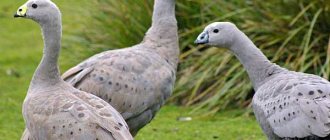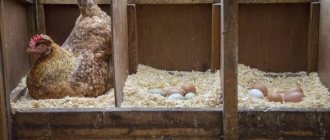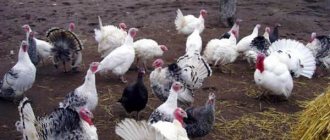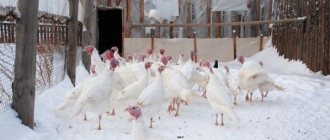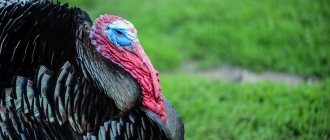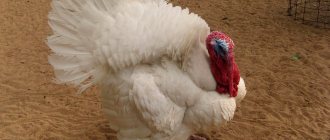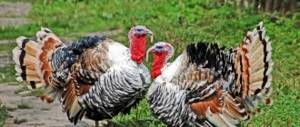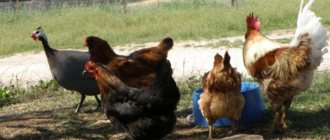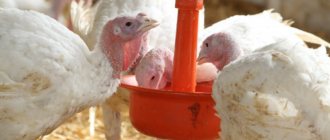Keeping chickens
Keeping chickens is more familiar to our farmers. As a rule, there are practically no difficulties in this matter. This popular bird is raised for its tasty meat and eggs, which are consumed in large quantities by the residents of our country.
Laying hens each produce up to 200 eggs per year. Chickens also love warmth, so poultry houses are specially prepared for winter. The optimal temperature for year-round maintenance is +23-25 degrees. Speaking of chickens, the breed of the bird and its purpose are also of great importance. The nutrition of chickens, especially if they are fattened for meat, is represented by more fatty feed. Their diet includes:
- corn and oats (rich in fat);
- pumpkin, corn, carrots, fish oil, sprouted oats, weeds (rich in vitamins);
- chalk, shell rock, egg shells (for calcium enrichment).
Chickens are fed 3-4 times a day, giving only grain at night. During cold weather, the amount of grain is also increased so that the bird is not too fatty.
Chickens often suffer from attacks by mites, lice, fleas and other insect pests. If you do not treat the chicken coop and do not keep it clean, the livestock may be destroyed. Keeping chickens involves setting up ash baths. They use convenient boxes with a special mixture of:
- ash;
- sand;
- dry clay.
Mix these components in equal parts. Chickens take such baths on their own, they are beneficial and get rid of parasites that spread infection. You can further familiarize yourself with some of the rules for keeping chickens using laying hens as an example by watching the video below:
What conditions are needed to keep chickens?
Chickens are very unpretentious both in the choice of food and in the conditions. They can even live in a small barn. It is not advisable to do this, however, if there is no other possibility, then the chickens can be placed in a rather cramped barn, letting them walk outside all day. A pen for chickens also does not require large sizes, but it should be more spacious.
The choice of diet for chickens is quite simple: they are practically omnivorous. In winter, they can be given boiled wheat, corn, peeling vegetables. This can be diluted with dry cereals. In the summer it is easier for the farmer: you can give the chickens almost any food from the garden.
On a note! Chickens are omnivores.
Keeping chickens and turkeys together
The presence of several species of birds in a single closed area invariably leads to the emergence of various kinds of problems, which largely depend on factors such as:
- bird breed;
- number of birds;
- conditions of detention;
- quality of care.
The necessary conditions
Experts recommend adhering to the following rules for the coexistence of chickens and turkeys:
It is best to start keeping birds together in a single area from an early age. Chicken and turkey chicks should be placed in the house at the same time. In this case, they will quickly get used to each other, and interspecies conflicts will not arise. If adult birds are moved into an inhabited chicken coop, fights are possible, and since chickens and turkeys are in unequal weight categories, such conflicts can result in the death of individuals.
Providing enough space for each bird will help reduce the risk of bird-to-bird collisions. When building a chicken coop, you should calculate its dimensions based on the norm of 0.5 m² per chicken and 0.8 m² per turkey. You should also pay close attention to the size of the walking yard. Since each bird should be able not only to move freely, but also to “jog”, its size should be large enough. The physical activity of poultry is the key to their health and good egg production. If necessary, the walking yard can be covered with a net or awning or the bird's wings can be clipped in order to prevent the bird from flying over the yard fence. Poultry houses often separate walking areas for each type of bird, which promotes the normal coexistence of different breeds.
Maintaining cleanliness. Because turkeys are more susceptible to bacteria from the dirt and droppings in the coop, house cleanliness must be monitored at all times. Farmers should clean up after their livestock more often to avoid outbreaks of various diseases. When keeping different types of poultry together, and possibly other livestock in winter, air humidity should be kept under control. A large population leads to an increase in humidity levels, which means it needs good air exchange.
Prevention of parasites and diseases. Crowding of livestock in a single room can contribute to the spread of fleas, ticks, lice eaters, as well as various diseases
Regular change of litter, cleanliness, and treatment with anthelmintic drugs in the poultry house are important preventive measures.
Features of feeding
Despite the external similarity of chickens and turkeys, their diet is somewhat different. When creating joint conditions for these two types of poultry, it is necessary to provide for the possibility of their separate feeding by organizing separate feeders and drinkers.
Feeding of poultry should be carried out taking into account the biological characteristics of the species, breed, level of productivity, age, sex, and conditions of detention.
Advantages and disadvantages
The main advantages of keeping land birds together include:
- savings on the construction of one common room, instead of two separate ones;
- saving space on the site, because one common aviary is being built for the birds;
- it is easier and faster to care for the livestock.
Experienced poultry farmers say the main disadvantage of keeping chickens and turkeys together is the susceptibility of turkeys to diseases that are common to all chickens.
Keeping turkeys requires careful adherence to sanitary standards and regular use of medications for prevention.
Keeping turkey poults, especially modern meat crosses, together with chickens is not allowed. Chickens can carry diseases without becoming sick themselves.
One of the disadvantages of sharing poultry housing is the difference in the size of the birds. And although turkeys are rarely pugnacious and do not offend chickens, large individuals require more food. If you do not correctly calculate the feed requirement of the entire livestock, turkeys can “eat up” chickens, taking food from them according to the “right of the most powerful.”
Broiler and regular chickens together
Is it possible to plant pumpkin and zucchini together?
In the early stages of growing chickens, feeding and temperature conditions do not differ for them. Starter feed has a high protein and metabolizable energy content and is suitable for all types of poultry. After 14 - 18 days the difference in the size of the chicks becomes noticeable (broilers grow much faster), they should be placed in different brooders. Otherwise, larger broilers may push simple chickens away from the feeders.
Ross's chickens
After 20 days, the future laying hen is replaced with food that is less high in calories, but more fortified with vitamins, and is provided with active exercise. Broilers require highly nutritious feed until the end of growing; they do not need walking.
Turkeys and chickens cannot be neighbors
It will not be possible to keep poultry such as turkeys and chickens together. Their living together in the same house is unacceptable! Since chickens are more active birds than turkeys, they will simply peck their larger neighbors.
Determining healthy birds by appearance
Turkeys should also not be kept near chickens, as they become infected with heterakis worms. If this parasite is not dangerous for chickens, it can kill turkeys.
Due to the fact that turkeys are sometimes fed like hens and chicks, certain problems arise. Keeping a turkey requires completely different knowledge, the rules here are different compared to the methods of breeding hens and chicks. The behavior of these birds is different, hence the difference in needs. Thus, they cannot be kept together in one place.
The priority for keeping poultry should be their safety.
Both turkeys and chickens are considered weedy birds, large-footed, however, unlike chickens, turkeys dig the ground with their paws and graze differently. A turkey's legs are strong, so it can walk long distances. While running, this bird is capable of reaching speeds of up to 50 km/h and maintaining it for a distance of 1.5 km!
The turkey's tibia, shin and tarsus grow very quickly. And the legs of a turkey can carry such a large body weight, and over long distances, thanks to the hard, strong bones in the ankles. The leg muscles of this bird contain a lot of zinc, which makes bones, muscles and tendons stronger. Therefore, if you want to saturate your body with this element, it is recommended to eat turkey leg meat.
Turkey histomoniasis
It is believed that turkeys get sick more often than other poultry, and this is true. Compared to the same chickens, turkeys have a higher pH level, and bacteria harmful to poultry multiply well in it.
If you keep a turkey, you need to know that you can give it bitter plants and insect chitin, due to which the secretion of hydrochloric acid and gastric juice increases and the pH level decreases.
Due to the high alkaline pH, a turkey can get sick with various diseases, in particular histomoniasis, in which the bird's stomach and cecum become inflamed.
The cause of this disease is the single-celled flagellate Histomonas meleagridis, which develops precisely at a high alkaline pH, which is observed in the cecum of turkey - 7.6-8.6.
Salpingitis in poultry
Chickens do not suffer from histomonosis so often, since the pH level in their cecum is approximately 6.8, and you don’t have to worry too much. This is another reason why a turkey cannot live with chickens in the same house; they must be kept separately.
The Americans conducted experiments with chickens - they deliberately infected them with flagellates. The birds' bodies did not fight single-celled parasites in any way, but there were quite a lot of them in the chicken, however, no signs of histomonosis were observed.
Turkeys also need B vitamins more than chickens; they react more sharply to their lack. This especially applies to B1 (thiamine), due to the lack of which polynephritis develops in turkeys. The development of this disease can be prevented by feeding poultry yeast and ensuring an increase in organic fiber in the diet. Knowing these subtleties will make keeping turkeys easier.
Yeast contains chitin, which is beneficial for birds, and grain fibers contain glucans and mannans, which increase the birds’ body resistance.
Turkey nutrition chart
The fact that turkeys tolerate unfavorable conditions less well is explained by the fact that their lungs and heart are very small in relation to their body weight. In other birds this is different.
Another significant difference between a turkey and a chicken is that these birds take different amounts of time to form “corals”. Because of this, keeping these poultry together is also not recommended. During the period of “coral” formation, birds are inactive, look drowsy, and you can often see their wings drooping. To help turkeys get through this difficult time easier, include in their diet:
- bitter plants;
- Luke;
- garlic;
- spices
Since the turkey is a massive bird and has a very large chest, it does not tolerate overheating very well. In our country, it is easier for this bird to escape from the cold than from the heat. Due to overheating, the turkey begins to drink a lot of cold water. This causes the goiter to sag.
The bird begins to lose weight and may die because bacteria develop in the crop, affecting the intestines or lungs. At the same time, the weakened bird is attacked by stronger turkeys, which can also cause death.
Why turkey and chicken can't be neighbors
If we consider the issue of keeping poultry together in general terms, then the proximity of chickens and turkeys is the most successful, unlike other birds, since both species prefer to sleep on wooden perches and build nests at the top. But that's where their similarities end. In all other respects, these birds are completely different, from the diseases that they can give each other to the dissimilarity of morals.
Character traits
Different personalities are one of the main reasons why turkeys and chickens cannot get along together. Chickens are more active and mobile, in addition, some breeds are quite aggressive, so they can be the first to attack turkeys, despite their formidable appearance. In particularly conflicting cases, chickens can simply peck at them. At the same time, male turkeys love to show character and often get into fights with chickens. And this is a serious matter - given the dimensions of both types, it is not difficult to predict who will emerge victorious in such an unequal battle.
Conditions of detention
Among all types of poultry, turkeys are considered the most demanding to keep. Firstly, they are quite large (some broiler breeds can reach a weight of 30 kg), and therefore they need a lot of space. And, secondly, they are very sensitive to cold, dampness and drafts. When arranging a poultry house, it is necessary to pay a lot of attention to creating favorable conditions - the room should be clean, dry, well ventilated, and, preferably, heated.
It is important to understand that dirt or high humidity in a poultry house is enough to seriously weaken the birds’ bodies and even lead to illness. Therefore, it is necessary to always monitor the cleanliness of the floor mat and change it regularly
Considering the high sensitivity of turkeys’ paws to cold, warm natural materials should be used as bedding: hay, straw, dry soft sawdust
Therefore, it is necessary to always monitor the cleanliness of the floor mat and change it regularly. Considering the high sensitivity of turkeys’ paws to cold, warm natural materials should be used as bedding: hay, straw, dry soft sawdust.
Chickens are less demanding on conditions. They feel comfortable in small chicken coops, the main thing is that there are perches for sitting and sleeping, as well as nests for laying eggs. Chickens live well in flocks; in cold weather they often crowd together to keep warm, therefore, any room can be suitable for keeping them, even without heating, which is completely unacceptable for turkeys.
It will also not work to feed turkeys together with chickens. First of all, because turkeys, due to their size, eat a lot and quickly, which is why slow blackbirds do not have time to grab the food and remain hungry. There is a more significant reason - these are different biological characteristics of the birds’ bodies. In turkeys, the pH level is shifted towards the alkaline side, while in chicken it is almost neutral. This circumstance dictates certain feeding rules.
If a chicken, in principle, can eat grains and pasture, then turkeys require a balanced and varied menu, in which not the least place is occupied by products that equalize the pH: chitin and bitter plants, which are contraindicated for chickens.
It is known that turkeys are more susceptible to diseases than other birds. And this is due, first of all, to the same increased pH level. It is because of this that bacteria that enter the turkey’s body develop faster than those of chickens and other birds. Elevated pH levels cause a disease such as histomoniasis, which leads to inflammatory processes in the liver, stomach and intestinal tissues. Chickens suffer from histomoniasis much less frequently, however, being a carrier of the disease, they can easily infect their neighbors.
There is also a downside to this situation. It is believed that turkey feces contain many microbes, in particular, pathogens of infectious diseases, and since chickens often row and peck various debris, there is a high probability that these microbes can enter their body. There are cases where the entire population of chickens died from infectious typhus.
Another danger that awaits both species of birds when living together is helminths, which they can become infected with from each other. Heterakis gallinarum is the most dangerous microorganism that chickens can infect turkeys with. For the chickens themselves, these protozoa do not pose any particular danger, while for turkeys they can cause death.
Is it possible to keep chickens and turkeys together?
Chickens and turkeys are very similar in appearance, so many people think that living together in a poultry house is the norm
However, each type of domestic bird requires special conditions of keeping and feeding, which also needs to be taken into account
What is the advantage
- Saving money. A common poultry house eliminates the need to erect a separate building to house each type of domestic bird or to create a walking yard. However, you should not save on creating feeders and waterers; this can significantly affect the health and microclimate in the poultry house.
- Save time. Cleaning the poultry house, which involves creating and maintaining cleanliness, timely replacement of bedding, microclimate control, supply of fresh feed and water - all this takes a lot of effort and time.
- Possibility of compact placement in a small area. In conditions where a poultry farmer has a small plot of land, creating a compact but functional shared poultry house can be an excellent solution.
Did you know? Chickens love to take ash and sand baths. To do this, place a box with a dry mixture of these bulk substances in the chicken coop. By bathing in them, birds independently cleanse themselves of parasites.
Flaws
- Difficulties of character. The individual characteristics of birds can be clearly expressed, and this in turn can lead to problems of several species of birds living together in the same territory. For example, turkeys are very capricious, while chickens can be aggressive towards neighbors with “character”.
- Carriers of dangerous diseases. Turkey feces often contain causative agents of a terrible disease - infectious typhus, which can spread quickly. As a rule, it leads to epidemics and significant bird mortality. In addition, chickens can infect turkeys with heterakis worms, which are not dangerous for the former, but are destructive for the latter.
- Different nutritional needs. Turkeys and turkeys are heavier than hens and roosters, which means they require more food and are not averse to enjoying an additional portion of nutrients, while chickens may not get food from the common feeder at all.
- Various motor needs. Chickens are very energetic and spend most of their time on the move, while turkeys prefer a calmer pace of life and can suffer from lively neighbors.
- Nutritional features. The need for vitamin B in turkeys is many times higher than in chickens. Its deficiency threatens the occurrence of pyelonephritis, and therefore their diet should contain yeast and plant fiber.
Feeding a mixed flock
It is important to follow the feeding order. Geese feed first
Afterwards the ducks get the food, then the chickens.
Let's give examples of diets.
In November-March, geese are fed:
- Grain – 150 g;
- oatmeal and chaff – 100 and 50 g;
- bran – 70 g;
- hay and root vegetables - 150 g each;
- boiled potatoes – 300 g;
- bone meal – 3 g;
- salt – 3 g.
The winter diet of meat 60-day-old and grown-up ducklings is presented:
- Chopped herbs – 80 g;
- boiled meat waste – 25 g;
- boiled potatoes – 80 g;
- ground barley, oats and corn – 100 g;
- wheat bran and ground grain waste - 40 g each;
- ground cakes and meal – 20 g.
47-week-old laying hens are fed daily:
- Wheat, barley – 40 and 30 g;
- boiled potatoes – 50 g;
- meal and yeast - 14 g each;
- fish waste – 10 g;
- pumpkin and greens – 20 and 30 g;
- bone meal, chalk and shell - 1, 3 and 5 g.
We suggest you read: Common diseases of ducks and their prevention. Vitamin deficiencies in ducks. Infectious diseases of ducks.
Why can't this be done?
It is better not to keep turkeys and chickens in the same house. And there are many reasons for this: from the dissimilarity of morals to the diseases that they can transmit to each other.
This is true. Chickens are more active birds than turkeys. And despite their menacing appearance and large size, domestic hazel grouse can simply peck at them.
Some owners who decide to place these two completely different species of birds together begin to give them the same type of food. Because of this, more problems are added. Chickens are unpretentious in this regard, but turkeys need a varied menu. For example, you need to know what types of plants and chitin can be given to them.
Turkeys do not tolerate poor housing conditions due to the fact that the heart and lungs are very small in relation to the body.
The above problems can be solved and somehow organize the proximity of birds. But one of the most important reasons why birds should not be housed together is because of diseases that they can contract from each other.
Keeping turkeys is a troublesome business. They get sick more often than any other living creature in the household. Their pH level is higher than that of the same laying hens, which is why bacteria in their bodies develop faster.
It develops due to the fact that inflammatory processes begin in the stomach and rectum. The disease is provoked by histomonas meleagridis, a single-celled flagellate for which the conditions for development in the turkey body are favorable.
Chickens do not often suffer from this scourge, since their pH is approximately 6.8. But they can infect larger neighbors (turkeys) with it.
The turkey is a massive bird with a large chest. Therefore, it is difficult for him to tolerate overheating. It is easier for him to be in the cold than in the heat. Due to excessive thirst, he drinks a lot of water, and because of this, his crop sag. It accumulates bacteria that destroy the lungs and intestines. All this can end in death.
- Chickens can infect their large but capricious neighbors with deadly heterakis worms. For the laying hens themselves, this parasite poses no danger.
- Blackhead is another disease that kills turkeys. It manifests itself in the form of inflammation of the liver and cecum and leads to enterohepatitis. The cause of this disease is also helminths that live in the body of chickens. Moreover, the worms remain viable, even being excreted along with the droppings.
If you already keep chickens and turkeys together - important rules
But what to do if turkeys and chickens are already adjacent to each other and due to limited space there is no way to resettle them?
Many poultry farmers admit that they have experience of such a neighborhood and share tips on how to make living together comfortable.
VIDEO INSTRUCTIONS » alt=»»>
What kind of poultry can you keep chickens and turkeys together with?
The proximity of chickens and turkeys is one of the most optimal than other bird species. Because both species sleep on wooden poles and their nests are located at the top. But for lack of space, you can put more ducks and geese in one house. You just need to take into account some nuances.
Shared content
When you open any professional literature on poultry keeping, you will definitely come across a recommendation not to keep turkeys and chickens together. When it comes to home maintenance, here are our recommendations. When organizing a farm for business, you need to approach the issue more seriously and professionally.
General recommendations
When starting a farm, the main task is to reduce risks as much as possible. Each bird is a farmer’s income, which no one wants to lose. Of course, with home breeding everything is much simpler.
Turkeys do not like either heat or cold; they need to be bred based on this data. It is ideal if such a bird has two poultry houses at once: summer and winter. The summer one should be well ventilated, and the winter one should be warm and light. When keeping turkeys and chickens together, take into account the following differences:
- in nutrition;
- in content;
- in common diseases.
The larger the turkey, the more space it needs to be housed. When raising turkeys on farms, they try to separate the females from the males. This makes it easier to record the egg production of birds. The same rule applies to laying hens. Order on the farm is the key to rapid business development.
Let's talk about why it is still not recommended to keep different birds together. This applies not only to those previously listed. Chickens, turkeys, ducks and guinea fowl all need to be housed separately when it comes to proper housing.
Problems when housing different birds together
Sooner or later, every farmer will face problems if chickens, turkeys and other poultry are kept together. It all depends on various factors:
- breeds;
- accommodation conditions;
- number of goals;
- farmer's care capabilities.
According to reviews, problems can be avoided if the farm is small, or when poultry houses are set up at home, where control over chickens and turkeys is maximum.
What problems should you watch out for?
- Poor nutrition. When turkeys and chickens are kept together, the former can accumulate fat excessively, suffer from an abundance of grass at an early age, and so on.
- Aggressive behavior. Some breeds of turkeys can be aggressive towards chickens and slaughter young animals. This requires dividing the birds, since you can lose a large part of the population. In this case, many farmers recommend raising turkeys with chickens from an early age, but no one can give an absolute guarantee that there will be no aggression from larger birds.
- Diseases. Chicken diseases are dangerous for turkeys and vice versa. When an infection (for example, histomoniasis or enterohepatitis) passes from turkeys to chickens, it will be extremely difficult to cure the latter. If we are talking about young animals, then you can lose the entire brood. Chicken droppings are also dangerous for turkey poults. This reason is the most important when recommending not to keep different birds together.
- Turkeys can crush chicken eggs in nests. If this happens, the farmer will have to urgently separate the poultry, which is sometimes very difficult to do.
That is why veterinarians recommend that at the initial stage you set up a farm according to all the rules. Chickens and turkey poults are very demanding in terms of care and maintenance. The risk of infection with viruses and death due to improper nutrition is extremely high.
If you are opening a professional farm, remember: the veterinary service will not issue an opinion on it if you plan to walk various birds together, fatten them and live in them. Keeping chickens and turkeys in this manner is an exception when it is simply not possible to do otherwise at home.
How to feed the young?
In order for chicks to grow well, they need a certain diet. It is made balanced in proteins, fats, carbohydrates, minerals and vitamins. When feeding, certain standards are observed. A newborn chick consumes 10 g of food for the first week. The turkey poult is given 40 g.
More on the topic: What breeds are bronze turkeys divided into?
The composition of the mash does not differ. They consist of boiled eggs, cottage cheese, skim milk, and herbs from the garden. Subsequently, the birds are fed cereals, legumes, and bran. Mineral and protein supplements are introduced into the diet. Experts suggest the following diet for birds up to one month of age:
- 30% – corn;
- 25% – wheat;
- 10% – barley;
- 15% – cake;
- 10% – bone meal;
- 3% – yeast;
- 2% – grass;
- 2% – return;
- 1% – chalk and salt;
- gravel is given - 1 g per head.
Subsequently, the supply of corn is reduced and the rate of barley is increased. For laying hens, at least 20% of succulent feed is added to the diet: carrots, beets, pumpkin, greens from the city, meadow grass. Chickens eat 2 times less than turkey poults. Excessive feed consumption can lead to various pathologies:
| № | Helpful information |
| 1 | improper formation of the gastrointestinal tract |
| 2 | blockage of the crop or intestines |
| 3 | disturbance of intestinal motility |
| 4 | obesity |
| 5 | delay in puberty |
| 6 | abnormal formation of reproductive organs |
| 7 | lack of egg production |
Young birds of various species are kept in the same room, but in different enclosures. A large amount of mash is prepared at once, but chickens are given it in smaller quantities than turkey poults.
It is important that the formation and development of all systems in the chicks’ bodies take place without pathologies
Tips for keeping turkeys
The maintenance of these exotic birds depends primarily on their breed. Many broiler varieties are quite unpretentious in choosing a diet. They enjoy eating not only feed, but also cereals and wheat.
Birds love to feast on seasonal vegetables, herbs, and plant tops. The main thing that a farmer should be guided by when preparing food for his pets is a balanced diet.
You should strictly monitor the content of your diet, not only proteins, fats, carbohydrates, but also vitamins. Minerals and macroelements contribute to the development of the musculoskeletal system in domestic turkeys.
Chicks and young birds especially need vitamins. Without them, the normal functioning of vital organs is impossible. With a lack of nutrients and macroelements, underdevelopment of the nervous system, general apathy and fatigue are observed.
It is also important to maintain water balance. Water is the source of all life on earth. No living organism can do without a sufficient amount of drinking water. Provide turkeys with drinking bowls of water, monitor its quality and purity.
Prolonged dehydration can cause serious disturbances in their metabolic processes. In fact, individuals will not be able to gain body weight in the required amount. And this is not beneficial for any farmer.
About
Incubation Features
Along with the development of the embryos, the breeding conditions also change:
On days 1 to 8, it is important to turn the eggs on time. Do at least 6 inversions. 8 to 14 day
The eggs continue to be turned 6 times a day. Starting from the 10th day, the incubator is ventilated and cooled - 2 times a day for 5-10 minutes. 15 to 24-25 days. Now 4 inversions are enough. Monitor the humidity and temperature conditions - the eggs should not dry out or overheat. Increase the humidity in the incubator. The apparatus is regularly ventilated - the embryos consume oxygen from the air, it is necessary to ensure the supply of fresh air. The incubator is ventilated and cooled 4 times for 10-15 minutes. 25-27 days. There is no need to ventilate or turn the eggs. The temperature is reduced - the chicks must get used to the environmental conditions
8 to 14 day. The eggs continue to be turned 6 times a day. Starting from the 10th day, the incubator is ventilated and cooled - 2 times a day for 5-10 minutes. 15 to 24-25 days. Now 4 inversions are enough. Monitor the humidity and temperature conditions - the eggs should not dry out or overheat. Increase the humidity in the incubator. The apparatus is regularly ventilated - the embryos consume oxygen from the air, it is necessary to ensure the supply of fresh air. The incubator is ventilated and cooled 4 times for 10-15 minutes. 25-27 days. There is no need to ventilate or turn the eggs. The temperature is reduced - the chicks must get used to the environmental conditions.
During incubation, ventilation operates - the apparatus for this purpose has ventilation holes blocked by moving partitions. The frequency of opening the partitions depends on the design of the device.
The entire process of breeding turkey poults in an incubator is presented by the breeder in the video below:
What breeds can be combined
When it is not possible to make separate poultry houses for turkeys and chickens, this does not mean at all that we should abandon their breeding and maintenance. You just need to place small breeds of turkeys together with hens and roosters, so that in the event of a conflict the birds will not harm each other. Also, don’t put males together. Roosters and turkeys are more aggressive, but the “girls” get along well together.
Rules in case of forced combination
When moving into a shared house, you should follow these recommendations:
Birds must be taught to live together from a very early age. Chicks raised together will initially consider the other breed to be representatives of their genus. Living together helps turkeys and chicks learn healthy habits from each other. So, the former will rake the earth with their paws, making them stronger, and the latter will pluck the grass, receiving a sufficient amount of necessary vitamins
It is very important that a turkey and a chicken living together from the very beginning are less likely to infect each other with infections, because they develop increased immunity; The room in which the birds will be kept must be arranged in such a way that it is suitable for each species. It wouldn't hurt to split it into parts
For one chicken, 0.5 m kV is more than enough, and for a turkey, at least 0.8 m kV. The birds will settle on their own; it is enough to make higher perches and more spacious nests for the turkeys; Turkeys must be walked. These roosters can stay indoors all day, but they need to make several “jogs” a day for normal development. It is advisable to divide the territory with at least a net, because it is in free conditions that birds most often conflict and fight. Again, chickens can and should throw food on the ground, but turkeys are forbidden to eat this way; the food must be formulated universally, so that there is no danger for another species if it is consumed; Be sure to regularly give the birds medicine to prevent worms, clean the house and treat it with antiseptics.
